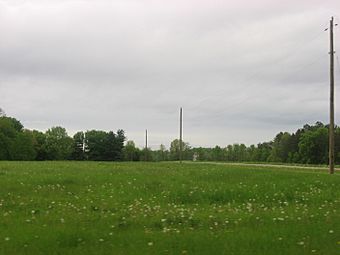Moar Mound and Village Site facts for kids
Quick facts for kids |
|
|
Moar Mound And Village
|
|

Overview of the site
|
|
| Location | Back a lane on the northern side of Lebanon-Union Rd., west of Morrow |
|---|---|
| Nearest city | Morrow, Ohio |
| Area | 20 acres (8.1 ha) |
| NRHP reference No. | 76001543 |
| Added to NRHP | January 1, 1976 |
The Moar Mound and Village Site is an archaeological site in the southwestern part of the U.S. state of Ohio. An archaeological site is a place where people lived or worked long ago, and we can find clues about their lives. This special area is located west of Morrow in Warren County. It includes two main parts: an ancient village area and a large Native American mound. The entire site covers about 20 acres (8.1 ha) of land. The Moar Mound is one of the few remaining mounds in southern Warren County. It has been kept in very good condition over many years.
Contents
What is the Moar Mound and Village Site?
The Moar Mound and Village Site gives us a peek into the lives of ancient people. It is a place where archaeologists, who are like history detectives, study the past. The site has two important features. One is a village area where people once lived. The other is a large earth mound, which was built by hand.
Who Lived Here? Ancient Woodland People
Experts believe that people from the Late Woodland period built the Moar Mound. The Woodland period was a time in North American history, roughly from 1000 BCE to 1000 CE. These ancient people were skilled builders and lived in settled communities. The mound itself is thought to be a burial place for one or more important individuals. It also held "grave goods," which are items buried with someone, perhaps for use in the afterlife.
Discovering the Past: What Archaeologists Found
The village area is directly connected to the mound. Archaeologists have found many burials there too. Archaeological excavations are like carefully digging up old sites to find hidden treasures. During these digs at the Moar Village, many different artifacts were found. Artifacts are objects made by humans, like tools, pottery, or jewelry. These discoveries make the Moar Mound and Village Site one of the most important archaeological places in Warren County.
The Burial Mound: A Special Place
The large mound at the site was carefully built by the Late Woodland people. It served as a special burial ground. Inside, archaeologists expect to find not just human remains but also items that were important to the people buried there. These items help us understand their beliefs and daily lives.
Village Life: Clues from Artifacts
The village part of the site was where people lived their everyday lives. By studying the artifacts found here, archaeologists can learn a lot. They can figure out what tools people used, what they ate, how they made pottery, and even how their homes might have looked. Each artifact is like a piece of a puzzle, helping us understand the ancient community.
Protecting History: National Register Listing
In 1976, the Moar Mound and Village Site was added to the National Register of Historic Places. This is an official list of places in the United States that are important to history. Being on this list helps protect the site. It was chosen because it has the potential to teach us even more about the ancient people who built the mound and lived in the village. Protecting such sites helps us preserve our shared human history for future generations.



